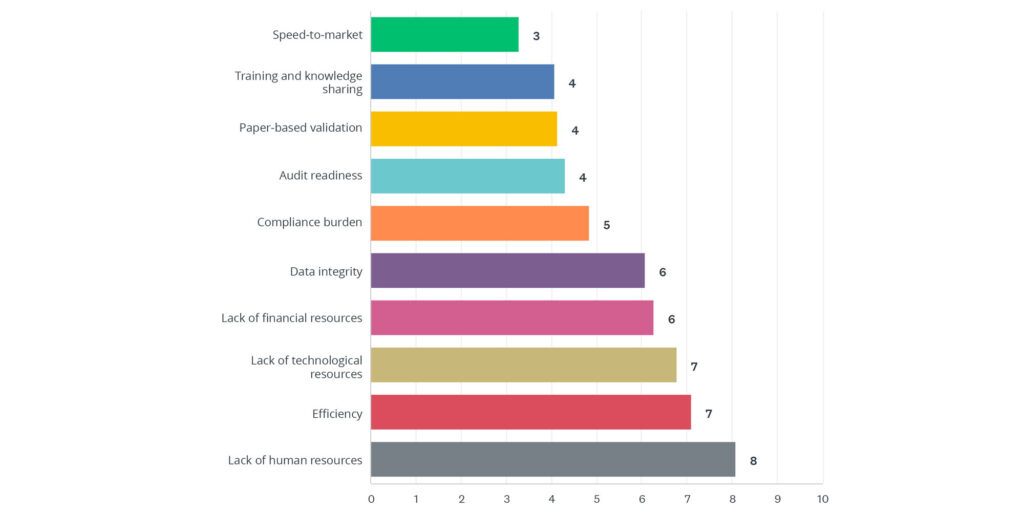In the realm of process validation, the shift from traditional siloed workflows to integrated processes is revolutionizing the landscape. Embracing a culture of collaboration not only streamlines validation efforts but also propels the industry toward more intelligent and efficient practices.
This article delves into the critical role of integration, focusing on digital validation systems that facilitate document management, drawing management, and the seamless integration of Process Analytical Technologies (PAT). Download the Digital Process Validation Guide to learn more about the evolution of process validation, the challenges and opportunities it presents, and the benefits of adopting a fully digital process-centric and data-driven approach.
The Silo Challenge in Process Validation
Historically, process validation has been compartmentalized, with different teams operating in isolation. This siloed approach poses challenges, such as delayed communication, duplicated effort, and general lack of efficiency. Breaking down these silos is essential for achieving smarter workflows that enhance efficiency and ensure compliance. Here’s how the integration of digital validation systems is transforming the validation landscape.
Embracing Digital Validation Systems for Document Management
Effective document management is a cornerstone of successful process validation. Traditionally, the documentation process has been time consuming and prone to errors. According to the 2023 State of Validation report, the most prevalent technology used by validation teams today is “Document or File Management Systems,” with 75% of survey respondents utilizing this type of system.
Such systems are crucial for managing and organizing various validation-related documents, ensuring easy access, version control, and compliance with documentation requirements.

Implementing a digital validation system allows teams to store, access, and collaborate on validation documents from a centralized repository. This eliminates the need for manual tracking and reduces the risk of version control issues. Documents, such as protocols and reports, become easily accessible to all relevant stakeholders, fostering transparency and collaboration.
Some digital validation systems, such as Kneat Gx, also offer Document Management, providing a centralized platform for document creation, review, and approval of non-native Kneat documents, both GxP and non-GxP, throughout their lifecycle to live alongside native Kneat documents. This reduces barriers for product teams so they can focus on enhancing product quality and accelerating production.
Digital validation systems also often come equipped with automated workflows that guide documents through various stages of validation. This ensures that each document is reviewed and approved by the appropriate personnel, streamlining the validation process. Automation minimizes bottlenecks, accelerates timelines, and reduces the likelihood of human errors.
Revolutionizing Drawing Management Through Integration
In the world of process validation, accurate and up-to-date drawings are crucial for understanding and documenting processes. However, managing drawings efficiently has often been a challenge. Digital validation systems such as Kneat Gx offer a solution by integrating drawing management into the validation process on a single platform.
By integrating drawing management into the digital validation system, process engineers can use the latest and approved drawings directly within the validation platform. Any updates or revisions to drawings are automatically reflected in the validation documentation. This integration ensures that teams are working with the most accurate information, minimizing the risk of errors associated with outdated drawings.
Digital validation systems provide robust version control features for drawings, ensuring that the entire team is working with the latest versions. This traceability not only enhances collaboration but also simplifies the auditing process. During inspections, regulators can easily trace the evolution of drawings and associated documentation, demonstrating a commitment to accuracy and compliance.
Kneat’s Drawing Management Module integrates with existing CAD systems to import drawings and incorporate them into your digital validation workflows. Remotely view, review, comment, reference, search, and more from any location, or take your drawings with you while performing electronic walk-downs. Learn more about our Drawing Management Module.
The Integration of PAT Technologies: A Game-Changer
Process Analytical Technologies (PAT) have become integral to process validation, offering real-time insights into the manufacturing process. However, the effective integration of PAT technologies into the validation workflow has been a challenge. Digital validation systems bridge this gap, creating a unified platform that incorporates PAT data seamlessly.
Digital validation systems can integrate with PAT technologies to capture real-time process data. This integration allows for continuous monitoring and analysis, providing a comprehensive view of the manufacturing process. By incorporating PAT data into validation protocols, teams can ensure that processes are not only validated but also optimized for efficiency and quality.
The integration of PAT technologies within digital validation systems enables the application of predictive analytics. By analyzing historical PAT data, process engineers can identify trends, potential deviations, and areas for improvement. This proactive approach empowers teams to make data-driven decisions, preventing issues before they impact the validation process.
Overcoming Challenges and Ensuring Successful Integration
While the benefits of integration are clear, the process of transitioning from traditional workflows to integrated systems comes with its own set of challenges. Resistance to change, training needs, and potential disruptions during implementation must be addressed strategically.
Implementing change management strategies is crucial for overcoming resistance to the integration of digital validation systems. Clear communication, training programs, and involving key stakeholders in the decision-making process can create a sense of ownership and enthusiasm for the transition.
To mitigate potential disruptions, consider a phased approach to implementation. Start with a pilot project to test the integration of digital validation systems for a specific validation process. This allows teams to identify and address challenges on a smaller scale before scaling up to full integration.
As part of its top-down digital strategy, a Top 10 global pharmaceutical and healthcare company implemented Kneat as a limited pilot project to digitalize Commissioning & Qualification (CQV) and Analytical Instrument Qualification (AIQ), at one of its continuous manufacturing facilities, to support its digital initiatives across the organization’s multiple business units.
As a result of this initiative, the customer’s manufacturing site achieved a 40% reduction in protocol review and approve time, and a 12% reduction in protocol development time. Read the full Case Study to learn more.
Final Thoughts
From validation to integration, the journey toward smarter workflows in process validation is marked by the seamless incorporation of digital validation systems. Breaking down silos through efficient document and drawing management, coupled with the integration of PAT technologies, transforms the validation process into a more collaborative, intelligent, and efficient endeavor.
By embracing these advancements, process engineers can not only streamline their workflows but also elevate the quality and compliance standards of their operations. The integration of digital validation systems represents a paradigm shift in process validation, propelling the industry toward a future where collaboration, efficiency, and innovation are at the forefront of every validation effort.
Learn More in the Digital Process Validation Guide
Process validation is complex and time consuming, but it has the potential to be a key competitive advantage. We’ve put together a Digital Process Validation Guide to show you how to get more from your process validation activities and execute faster.
In our guide, we explain the benefits of digital process validation, including how to leverage your existing data and documents to supercharge your production. You’ll gain insights from experts and learn why Kneat is the leading digital process validation solution in the industry.






